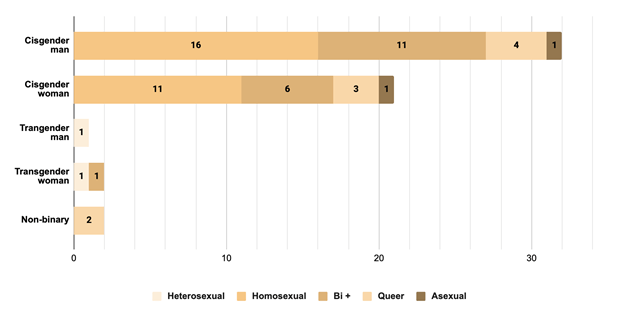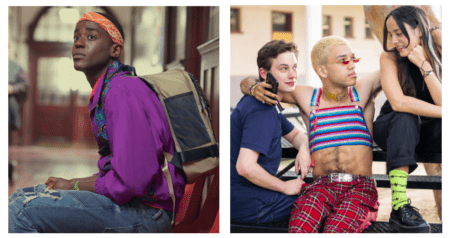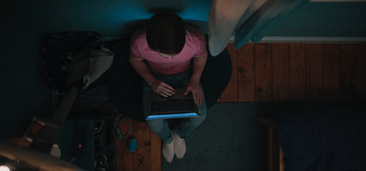Following the rise of global streaming platforms in recent years, there has been a seemingly simultaneous increase in the portrayal of LGBTQ+ characters in popular and – often – critically acclaimed series within the teen genre such as Sex Education (2019-2023), Euphoria (2019-) and Young Royals (2021-). Based on a mixed-methods study, this blog post sheds light on what this increase means for the textual representation of LGBTQ+ characters, on the one hand, and for the LGBTQ+ youth watching the series, on the other hand.
This is just me being me
First of all, the series portray a wide scope of queer identities, including sexualities and gender identities, such as asexuality and non-binary genders, that have had little to no representation on screen in the past.
Within our sample of 12 series focusing on queer stories [1], we found a significant number of LGBTQ+ characters appearing in prominent roles, either as regular or recurring characters, even within each individual tv series. We identified 128 LGBTQ+ characters of which 58 are regular characters and 37 are recurring characters, while the remaining 33 characters are guest appearances.
There’s no one way to be gay
Secondly, we found that the series presented a diverse and nuanced portrayal of LGBTQ+ characters with the same sexuality and/or gender identity, as they are portrayed with distinctive character traits. Likewise, a wide range of experiences and challenges related to being queer are depicted in the characters’ storylines, particularly which emotions the characters associate with being queer, how they come out, what queer relationships may look like, and how they are treated by non-queer characters.
Some of the harmful stereotypes that previously dominated LGBTQ+ representation are no longer present. For example, only a few of the characters fall into a narrative in which they tragically die, and bisexuality is no longer portrayed as a phase. However, stock characters are an integral part of the teen drama genre (Jenner, 2014, p. 136), not only among LGBTQ+ characters, and therefore it is difficult to steer clear of characters who are completely devoid of stereotypical character traits and behaviors.
In Netflix’ Sex Education, Eric (Ncuti Gatwa) fulfills stereotypes that typically define homosexual men in screen content. He is the flamboyant gay best friend of the main character, providing comic relief, yet also a victim of homophobia. However, his character development throughout the first season proves him to be a complex character who rises above the stereotypes. He eventually confronts his bully as well as his best friend, refusing to be victimized and treated as a subordinate sidekick.
Chester (Justice Smith) from HBO Max’ Genera+ion (2021) is likewise portrayed as an openly gay man with a feminine gender expression. But while Eric is an outsider, who is bullied by his peers for being gay, Chester is a popular star athlete on the school’s water polo team – a character trait not usually associated with the flamboyant homosexual man.
The two series thereby subvert the trope of homosexual men as “sissies” in different ways.
Although a range of tropes and stereotypes are depicted, our study finds that regular and recurring LGBTQ+ characters are less stereotypical than they might initially seem at surface level. Instead, they are portrayed as multidimensional individuals because they have greater agency, which allows for nuanced character designs and developments.
Ultimately, this means that regular LGBTQ+ characters are not defined solely by their queerness, which is what LGBTQ+ youth perceive as good representation.
Finding comfort in LGBTQ+ representation
The study finds that this representation impact LGBTQ+ youth in various degrees on various levels.
On an individual level, LGBTQ+ youth experience a sense of validation through the depiction of queer characters with experiences that are similar to their own. They find comfort in seeing their doubts, insecurities, and challenges reflected in popular culture, because it makes them feel acknowledged and affirmed.
It is also for this reason they started to seek out queer content. One interviewee elaborates: “I think it would have been difficult without any of these series, because then I wouldn’t have known that it’s actually common to have these thoughts”.
When queer youth feel more secure and confident in their own queer identity, they also feel more comfortable with expressing these parts of themselves outwardly.
A queer woman from the study shared that she only recently cut her hair short, something she has been wanting to do for years, but has held back from. According to her, she felt pressured to appear feminine as she often found masculine-presenting women portrayed as unappealing and sleazy on TV. However, recent portrayals have changed her mind: “I see characters who are different and accepted for who they are, so I’m hoping that will apply to me too in the real world.”
While LGBTQ+ representation may empower LGBTQ+ youth audiences, the interviewees make a point in emphasizing that the opposite is also true: that the representation of LGBTQ+ characters as stereotypical and one-dimensional is harmful to their self-perception and self-esteem. They feel that this representation highlights their otherness as LGBTQ+ individuals in a cisheteronormative society.
A part of something bigger
On a social level, the representation helps them associate their queer sexuality and/or gender as a positive aspect of their identity, because the characters are usually ones they want to associate with.
“Nowadays, all these cool characters are emerging, who don’t make it their entire personality that they’re queer,” one would explain. Seeing this kind of representation reinforces their desire to belong to the LGBTQ+ community, as they themselves want to be defined by more than just their queer sexuality or gender identity in their everyday lives.
Furthermore, their sense of belonging to the group is strengthened because they are familiar with the shared culture being represented. One person states that “I think it’s funny when heterosexuals don’t get the jokes.” Most interviewees relate to the experience of researching and taking online tests to find out whether they are queer, which is depicted in Heartstopper, Love, Victor, and Sex Education. “I have scoured the internet for coming out-videos myself,” another person laughingly explains.
Ordinary people with ordinary problems
And finally, on a societal level, the LGBTQ+ representation in popular TV series contributes to shaping a perception among queer youth that it is more common and socially accepted to be a queer person who is in opposition of cisheterosexual norms.
They express that the worldviews are contagious, so that when it appears to be more common on-screen to be queer, they do not feel as alienated in real life. Rather, they feel accepted despite their differences, and in some cases, even empowered: “I want to hold my fiancée’s hand when we’re walking in public even more now, because I know that people are getting used to it.”
Some of the interviewees mention that most of their heterosexual peers have also watched series such as Sex Education and Euphoria, which has additionally contributed to a sense of security, because it establishes a common ground between them. The interviewees experience that when they come out to non-LGBTQ+ members who have watched these shows, they are usually more empathetic towards them.
In other words, the increase of LGBTQ+ characters with complex traits and stories makes the interviewees feel more accepted, empowered, and safe in their daily lives, because these series show that queer people, despite their nonconformity, are not an Other, but simply ordinary people with ordinary problems.
Some problems remain
According to the interviewees, LGBTQ+ representation is heading in the right direction, at least in the teen dramas that choose to focus on queer stories. In the few months since this study was conducted, multiple series have continued to introduce even more LGBTQ+ characters in the subsequent seasons.
However, the study remains critical of the fact that much representation continues to concentrate on homosexual characters, and cisgendered queer men as illustrated above. Although less common sexualities and gender identities are represented, there are still very few of them, and they have little agency overall. Similarly, stories about other queer minorities, including dual identity minorities, are largely untold.
The findings of the study emphasize that scripted LGBTQ+ representation in popular culture must continue to be cautious in the way they create and present queer identities so as not to other their young queer audiences.
Ji Qi Lam and Caroline Maria Rynord both have a Master’s degree in Media Studies from Aarhus University. They share a great interest in popular culture and have collaborated on multiple projects, including one on the promotional value of post-credit scenes in the Marvel franchise. This blog entry summarizes their MA thesis A Colourful Portrait of Youth: A study of LGBTQ+ representation in teen TV as experienced by queer youth. Associate professor Pia Majbritt Jensensupervised the thesis.
References
Jenner, M. (2014). We Need to Talk about Jack! On the Representation of Male Homosexuality in American Teen Soaps. In: Pullen, C. (Ed.), Queer Youth and Media Cultures. London, UK: Palgrave Macmillan
Footnote
[1] Élite (season 1-6), Euphoria (season 1-3), First Kill, Genera+ion, Heartbreak High, Heartstopper (season 1), Love, Victor, Never Have I Ever (season 1-3), Sex Education (season 1-3), The Sex Lives of College Girls (season 1-2), Warrior Nun, and Young Royals (season 1-2).








